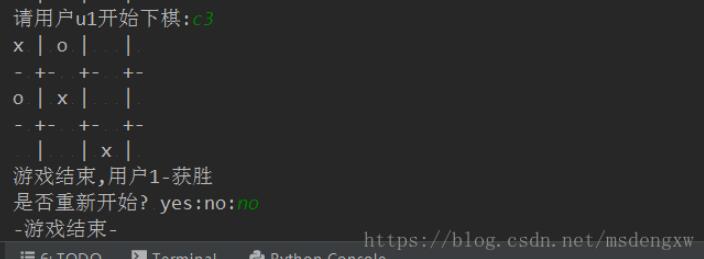python入门之井字棋小游戏
引言:
刚学python好几天了,从java到python,基础学起来确实比较容易,语法掌握,基本概念上都比较容易入脑。
唯一比较郁闷的是老想着用java的语法去学python代码,这点还需要后面慢慢掌握吧,相信学多种语言的你们也有这种经历吧。
start:开始上代码了,希望有更好的逻辑思维来写,自己也是用最笨拙的思路去写的,如果有可以优化的代码请各位大神指教
#!/user/bin/python
# -*- coding: utf-8 -*-
import os
import sys
#棋盘模块
def model(dictionary,serial=False):
if serial:
print('-(初版)井字棋游戏,输入棋号进行对战,')
print('对应棋号为第一行:a1-a2-a3',end=',')
print('对应棋号为第二行:b1-b2-b3',end=',')
print('对应棋号为第三行:c1-c2-c3')
print(dictionary['a1'] + ' | '+ dictionary['a2'] +' | '+ dictionary['a3'] +' | ')
print('- +- +- +-')
print(dictionary['b1'] + ' | ' + dictionary['b2'] + ' | ' + dictionary['b3'] + ' | ')
print('- +- +- +-')
print(dictionary['c1'] + ' | ' + dictionary['c2'] + ' | ' + dictionary['c3'] + ' | ')
#主模块
def main():
dictionary={'a1':' ','a2':' ','a3':' ','b1':' ','b2':' ','b3':' ','c1':' ','c2':' ','c3':' '}
model(dictionary, True)
u1 = 'x' #用户1
u2 = 'o' #用户2
stepNumber =1 #记录步数
break_fang = 0 #获胜者记录
while(stepNumber<=9):
fv = True # 判断条件2
while fv:
num = input('请用户u1开始下棋:')
compare=1 #判断条件1
for x in dictionary:
if x.find(num)!=-1:compare=0
if compare ==0:
fv=False
dictionary[num] = u1
model(dictionary)
# 0:继续 1,用户1胜,2,用户2胜
break_fang = forResult(dictionary)
if break_fang > 0: break
fv =True #清楚状态
stepNumber+=1
while fv:
num1=input('请用户u2开始下棋:')
compare = 1 # 判断条件1
for x in dictionary:
if x.find(num1)!=-1:compare=0
if compare == 0:
fv=False
dictionary[num1] = u2
model(dictionary)
break_fang = forResult(dictionary)
if break_fang > 0: break
stepNumber+=1
gameover(break_fang)
#退出下棋
def gameover(break_fang):
c = input('是否重新开始? yes:no:')
if c.find('yes')!=-1:
main()
else:
print('-游戏结束-')
return
#判断获胜情况
#dictionary:棋盘信息
def forResult(dictionary):
dicts= dict(dictionary)
if dicts['a1'] == dicts['a2'] and dicts['a2'] == dicts['a3'] and len(dicts['a3'].strip())>0:
print('游戏结束,' + '用户1-获胜' if dicts['a1'] == 'x' else '用户2-获胜')
return 1 if dicts['a1']=='x' else 2
elif dicts['a1'] == dicts['b2'] and dicts['b2'] == dicts['c3'] and len(dicts['c3'].strip())>0:
print('游戏结束,' + '用户1-获胜' if dicts['a1'] == 'x' else '用户2-获胜')
return 1 if dicts['a1'] == 'x' else 2
elif dicts['a1'] == dicts['b1'] and dicts['b1'] == dicts['c1'] and len(dicts['c1'].strip())>0:
print('游戏结束,' + '用户1-获胜' if dicts['a1'] == 'x' else '用户2-获胜')
return 1 if dicts['a1'] == 'x' else 2
elif dicts['a2'] == dicts['b2'] and dicts['b2'] == dicts['c2'] and len(dicts['c2'].strip())>0:
print('游戏结束,' + '用户1-获胜' if dicts['a2'] == 'x' else '用户2-获胜')
return 1 if dicts['a2'] == 'x' else 2
elif dicts['a3'] == dicts['b3'] and dicts['b3'] == dicts['c3'] and len(dicts['c3'].strip())>0:
print('游戏结束,' + '用户1-获胜' if dicts['a3'] == 'x' else '用户2-获胜')
return 1 if dicts['a3'] == 'x' else 2
elif dicts['a3'] == dicts['b2'] and dicts['b3'] == dicts['c1'] and len(dicts['c1'].strip())>0:
print('游戏结束,' + '用户1-获胜' if dicts['a3'] == 'x' else '用户2-获胜')
return 1 if dicts['a3'] == 'x' else 2
elif dicts['b1'] == dicts['b2'] and dicts['b2'] == dicts['b3'] and len(dicts['b3'].strip())>0:
print('游戏结束,' + '用户1-获胜' if dicts['b1'] == 'x' else '用户2-获胜')
return 1 if dicts['b1'] == 'x' else 2
elif dicts['c1'] == dicts['c2'] and dicts['c2'] == dicts['c3'] and len(dicts['c3'].strip())>0:
print('游戏结束,' + '用户1-获胜' if dicts['c1'] == 'x' else '用户2-获胜')
return 1 if dicts['c1'] == 'x' else 2
else:
return 0
if __name__ =='__main__':
main()
补一点更改思路:forResult()的另一种实现,compares()函数:少了6行代码量。
def compares(dictionary={'':''},string=''):
if len(dictionary)>0 | len(string.strip())==0:print('传值为空!')
else:
axle =('a1','a3','b2','c1','c3') # 四个角和中间的数特殊判断 条件1
axle_fang=False #特殊棋号需要多加一种可能性
for x in axle:
if string==x:axle_fang=True
if axle_fang: #条件1
if dictionary['a1']==dictionary['b2'] and dictionary['b2']==dictionary['c3'] and dictionary['c3'].strip()!=''\
or dictionary['a3']==dictionary['b2'] and dictionary['b2']==dictionary['c1']and dictionary['c1'].strip()!='':
print('游戏结束,' + '用户1-获胜' if dictionary[string] == 'x' else '用户2-获胜')
return 1 if dictionary[string] == 'x' else 2
# 拆分棋号 splitStr0,splitStr1,普通棋号只需判断俩种a俩种可能,上下-左右间的位置
splitStr0,splitStr1 = string[0],string[1]
print(splitStr0+":"+splitStr1)
if dictionary[splitStr0+'1']==dictionary[splitStr0+'2'] and dictionary[splitStr0+'2']==dictionary[splitStr0+'3']\
or dictionary['a'+splitStr1]==dictionary['b'+splitStr1] and dictionary['b'+splitStr1]==dictionary['c'+splitStr1]:
print('游戏结束,' + '用户1-获胜' if dictionary[string] == 'x' else '用户2-获胜')
return 1 if dictionary[string] == 'x' else 2
else:return 0
end:写完这些也有九十行代码量了,总感觉太多了。
控制台打印:


以上就是本文的全部内容,希望对大家的学习有所帮助,也希望大家多多支持我们。
赞 (0)

